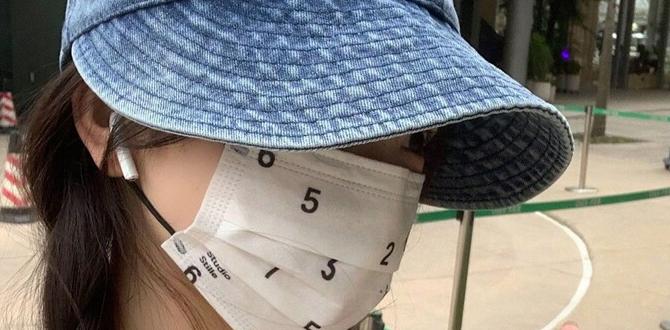Quick Summary: A catcher’s throat guard is a direct piece of protective equipment attached to the helmet to shield the player’s throat from errant pitches or foul balls. Umpire gear, on the other hand, is a broader set of protective equipment worn by the umpire, which may include a mask that covers the throat area but is not directly attached to a player’s helmet.
Catchers Throat Guard vs Umpire Gear: Essential Protection on the Diamond
Ever wondered about that little piece of plastic or metal sticking out from a catcher’s helmet? Or maybe you’ve seen umpires in their bulky protective gear and thought, “What’s the difference, and why is it so important?” You’re not alone! Understanding the protective equipment in baseball, especially for the catcher and umpire, is key to staying safe and enjoying the game. It can get a little confusing with all the different pieces out there. This guide will break down the catcher’s throat guard and umpire gear, explaining what they are, why they matter, and how they work together (or don’t!) to keep everyone safe on the diamond.
We’ll dive into the specifics of each, look at why a catcher needs their own dedicated throat protection, and what makes umpire gear distinct. By the end, you’ll have a clear picture of these essential safety components and feel more confident about your understanding of baseball safety.
The Catcher’s Crucial Defense: Understanding the Throat Guard
Behind home plate, the catcher is the unsung hero, often facing the most direct action. They receive pitches, frame the ball, and are in the line of fire for foul tips and wild pitches. This is precisely why they need specialized protection, and the catcher’s throat guard is a vital part of that.
What Exactly is a Catcher’s Throat Guard?
A catcher’s throat guard is a piece of protective equipment designed to extend downwards from the bottom of a catcher’s helmet. Its primary purpose is to cover and protect the throat area, a vulnerable spot that a standard helmet alone might not fully shield. These guards are typically made of durable plastic or metal and are strategically positioned to absorb the impact of errant pitches, foul balls, or even accidental contact during a play at the plate.
Think of it as an extension of the helmet’s safety system. Without it, a direct shot to the throat could be incredibly dangerous, potentially leading to serious injury. The guard acts as a crucial barrier, redirecting or absorbing the force of impact away from this sensitive area.
Why Do Catchers Need a Dedicated Throat Guard?
Catchers are constantly in a vulnerable position. They squat low, often with their head tilted slightly forward to get a clear view of the pitcher. This posture can expose their throat, especially when dealing with high-velocity fastballs, sharp breaking balls that can carom off the glove, or foul tips that fly straight up and back. Here’s a breakdown of why this piece of gear is non-negotiable for a catcher:
- Direct Impact Protection: The most obvious reason is to prevent direct blows to the throat from pitches or foul balls. A well-placed impact here can be devastating.
- Reduced Risk of Serious Injury: The throat contains vital structures like the larynx (voice box) and major blood vessels. A severe injury could affect breathing, speech, or even be life-threatening.
- Confidence and Focus: Knowing they are protected allows catchers to focus on their game – calling pitches, blocking balls, and making plays – without excessive worry about personal injury.
- Compliance with Rules: Many baseball leagues, especially at youth and amateur levels, have rules mandating the use of throat guards for catchers.
- Comfort and Fit: Modern throat guards are designed to integrate smoothly with various helmet models, ensuring they don’t impede vision or comfort during long games.
The design of catcher’s gear emphasizes protecting the player who is directly involved in the action around home plate. The throat guard is a small but mighty addition that significantly enhances this protection.
Types of Catcher’s Throat Guards
Throat guards come in a few variations, primarily differing in material and attachment style:
- Plastic Throat Guards: These are the most common and generally the most affordable. They are usually made of durable, impact-resistant plastic like ABS. They attach to the helmet with screws or clips and are lightweight.
- Metal Throat Guards: Less common for youth players, metal guards (often steel or aluminum) offer robust protection. They can be heavier but are extremely durable. These are sometimes seen at higher levels of play where impact forces are greater.
- Integrated Throat Guards: Some modern catcher’s helmets come with a built-in or integrated throat protector that’s part of the helmet’s design itself, offering a seamless look and feel.
Umpire Gear: The Official’s Comprehensive Safety Net
Umpires are the arbiters of the game, but they also stand in harm’s way, positioned as they are behind the pitcher and often near the action at home plate. While they aren’t players, their need for protection is paramount. Umpire gear is designed to be much more comprehensive, covering a much larger area of the body.
What Constitutes Umpire Gear?
Umpire gear is a full system of protective equipment designed to shield the official from impacts. Unlike a player’s specific gear focused on their role, what an umpire wears is designed for maximum protection against a wide range of potential impacts associated with being a stationary target for batted balls and thrown balls. Key components typically include:
- Umpire Mask: This is the most recognizable piece. It’s a cage-like structure, often made of steel or titanium, designed to protect the face, head, and neck. Unlike a catcher’s helmet, it’s a separate piece worn over the face and often straps to the head. Many modern umpire masks have extended padding or a built-in throat protector that dangles below the cage.
- Chest Protector: A padded vest worn over the torso that protects the chest, ribs, and abdomen from direct impacts. These can range from lightweight models for umpires making calls down the lines to heavily padded, rigid models for home plate.
- Shin Guards: Similar to those worn by catchers, but often designed for greater mobility and less bulk for umpires who move around the field. They protect the shins and knees.
- Plate Brush: While not protective gear, it’s an essential tool for home plate umpires to clear dirt and debris from home plate without needing to reach directly over it.
- Indicator/Counter: Used to track balls and strikes.
How Umpire Gear (Including the Mask) Differs from a Catcher’s Setup
The fundamental difference lies in the scope and purpose. A catcher’s throat guard is a specific addition to their helmet, focused on one vulnerable area. Umpire gear is a complete ensemble of protection designed for an official who is a more passive target but still at significant risk.
Key Distinctions:
- Scope of Protection: Catcher’s throat guards protect only the throat. Umpire masks protect the entire face and head, and often their masks have an extended piece that covers the throat, but it’s part of the mask, not attached to a helmet. Umpire gear also includes substantial chest and leg protection.
- Mobility vs. Static Protection: Catchers need to move quickly to block pitches and make plays. Their gear allows for a good range of motion. Umpires, especially home plate umpires, need robust protection because they remain in a relatively static position, directly in the path of pitches and foul balls.
- Attachment Method: A catcher’s throat guard is screwed or clipped directly onto their helmet. An umpire’s mask is a standalone piece worn over the face and secured by straps.
- Purpose: Catcher’s gear is designed to enhance the player’s ability to do their job safely. Umpire gear is designed to ensure the official can perform their duties without sustaining injury, thus allowing the game to proceed fairly.
Why is Umpire Gear So Much?
Umpires are often in the direct line of fire for foul balls and errant pitches. Unlike a catcher who can react and block, an umpire is typically trying to maintain a clear line of sight, making them a more stationary target. The full set of gear serves multiple critical functions:
- Face and Head Protection: The mask prevents serious facial fractures, eye injuries, and concussions that could result from being hit by a baseball traveling at high speeds.
- Torso Protection: The chest protector shields the ribs, sternum, and internal organs from impacts that could cause bruising, fractures, or more severe internal injuries.
- Leg Protection: Shin guards protect the lower legs and knees from foul tips or accidental kicks.
- Injury Prevention: This gear is designed to make the umpire’s job safer, allowing them to make close calls with confidence and reducing the risk of career-ending injuries. The National Athletic Equipment Manufacturers Association (NAEMA) provides standards for sports protective equipment, ensuring safety protocols are met.
The level of protection required for umpires is substantial due to their positioning and the nature of the game. It’s a testament to the respect for the officials and the commitment to player and official safety in baseball.
Catchers Throat Guard vs Umpire Gear: The Direct Comparison
Let’s lay out the differences and similarities clearly so there’s no confusion.
Table: Catcher’s Throat Guard vs. Umpire Gear Components
| Feature | Catcher’s Throat Guard | Umpire Gear (Key Components) |
|---|---|---|
| Primary Function | Protects the catcher’s throat. | Protects the umpire’s face, head, torso, and legs. |
| Attached To | Catcher’s helmet. | Worn independently (mask straps to head, chest protector is a vest, shin guards are strapped on). |
| Scope of Protection | Specific to the throat area. | Comprehensive head-to-toe protection. |
| Material Examples | Durable plastic, metal. | Steel/titanium cage (mask), dense foam/plastic (chest protector/shin guards). |
| User | Player (Catcher). | Official (Umpire). |
| Purpose in Game | Player safety during play at home plate. | Official safety allowing impartial game management. |
It’s clear that while both address safety, they serve different users and protect different parts of the body in distinct ways. A pitcher’s throw hitting a catcher’s throat guard is one scenario; a foul ball hitting an umpire’s mask is entirely different. The equipment is tailored to the specific risks each role faces.
The “Vs.” is About Purpose, Not Competition
When we talk about “Catchers Throat Guard vs Umpire Gear,” it’s not a competition. It’s about understanding that baseball has multiple layers of safety equipment designed for different individuals on the field:
- The Catcher’s Throat Guard: This is player-specific protection. It’s an accessory to the catcher’s helmet, designed to stop a speeding ball or errant bat from causing a severe injury to the throat. It’s about personal protection enabling a player to perform their demanding role.
- Umpire Gear: This is official-specific protection. It’s a full suit of armor designed to allow the umpire to do their job without fear of serious injury. The umpire’s mask is the closest point of comparison to catcher’s gear in terms of face protection, and many umpire masks do incorporate a throat protector element. However, the overall bulk, coverage, and design are vastly different from a catcher’s helmet and added throat guard.
The critical takeaway is that each piece of equipment is essential for the role it serves. A catcher cannot rely on the umpire’s mask for their throat protection, nor can an umpire adequately protect themselves with just a catcher’s helmet and throat guard. They are distinct systems for distinct roles.
Why Safety Gear is Non-Negotiable at Home Plate
Home plate is often the hub of intense action in baseball. It’s where the pitcher-catcher duel culminates, where close plays happen, and where the most dangerous projectiles (pitched balls, batted balls) are most likely to fly. This makes protection here absolutely critical for both players and officials.
Risks at Home Plate:
- High-Velocity Pitches: Even an intentional pitch can go errant.
- Foul Tips: These are balls hit off the barrel or handle of the bat that “tip” backward towards the catcher or umpire. They can be exceptionally fast and unpredictable.
- Batted Balls: Hard-hit ground balls or line drives can ricochet.
- Collisions: Runners sliding or attempting to score can collide with the catcher.
- Accidental Contact: Bats can slip from a batter’s hands or be swung wildly in a checked swing.
The governing body for baseball in the United States, USA Baseball, has established safety regulations and recommendations that emphasize the importance of appropriate protective equipment. For instance, their official rules often stipulate required gear for certain positions. Organizations like the National Operating Committee on Standards for Athletic Equipment (NOCSAE) also set stringent standards for protective gear to ensure it meets rigorous safety tests.
The combination of a catcher’s helmet, throat guard, chest protector, and shin guards, alongside the umpire’s full gear set, creates layers of safety that significantly mitigate these risks. This allows the game to be played at high speeds and with competitive intensity, knowing that the individuals most at risk have robust protection.
Choosing the Right Gear: Considerations for Players and Umpires
While this article focuses on the difference, it’s worth noting that selecting protective gear is a personal choice based on comfort, fit, and level of play. However, for catchers, a properly fitted helmet with an attached throat guard is paramount. For umpires, the fit and coverage of their mask, chest protector, and shin guards are crucial.
Key Fit and Function Factors:
- Fit: Gear should fit snugly without being restrictive. A loose mask can shift upon impact, and ill-fitting shin guards won’t provide adequate protection.
- Coverage: Ensure the gear covers the intended vulnerable areas completely. A throat guard should extend sufficiently. An umpire’s mask should leave no gaps around the face.
- Comfort and Mobility: While protection is primary, comfort is important for focus. Modern gear balances these well.
- Durability: Invest in gear from reputable brands known for quality materials and construction.
- League Rules: Always check your league’s specific equipment requirements.
For players looking to purchase catcher’s gear, resources like those found on official baseball equipment manufacturer websites or comprehensive sports retailers often provide sizing guides and product specifications. Similarly, umpire associations or organizations like the National Association of Sports Officials (NASO) can offer guidance on appropriate gear selection.
Frequently Asked Questions (FAQ)
Q1: Is a catcher’s throat guard the same as what an umpire wears to protect their throat?
A: No, they are different. A catcher’s throat guard is a separate piece attached to their helmet to protect their throat. An umpire’s throat protection is typically an extension of their umpire mask, which is a standalone piece of gear covering the entire face and head.
Q2: Why can’t a catcher just rely on the umpire’s mask for throat protection?
A: A catcher isn’t typically close enough to the umpire to benefit from their mask. The catcher is behind home plate receiving pitches, and the umpire is usually positioned behind the catcher or slightly to the side. The catcher needs their own equipment for immediate protection.
Q3: Do all catcher’s helmets come with a throat guard?
A: Not all helmets come with one pre-attached, but most modern catcher’s helmets are designed with the ability to attach a separate throat guard. Many youth leagues and official rules mandate that catchers wear a throat guard.
Q4: What is the main difference in the purpose of catcher’s gear versus umpire’s gear?
A: Catcher’s gear is designed to protect a player while they actively perform demanding defensive actions. Umpire’s gear is designed to protect an official who officiates the game and is often in the direct path of play, requiring more comprehensive, all-around protection.
Q5: Can a baseball player use umpire shin guards?
A: While shin guards share a similar purpose, catcher’s shin guards are typically






